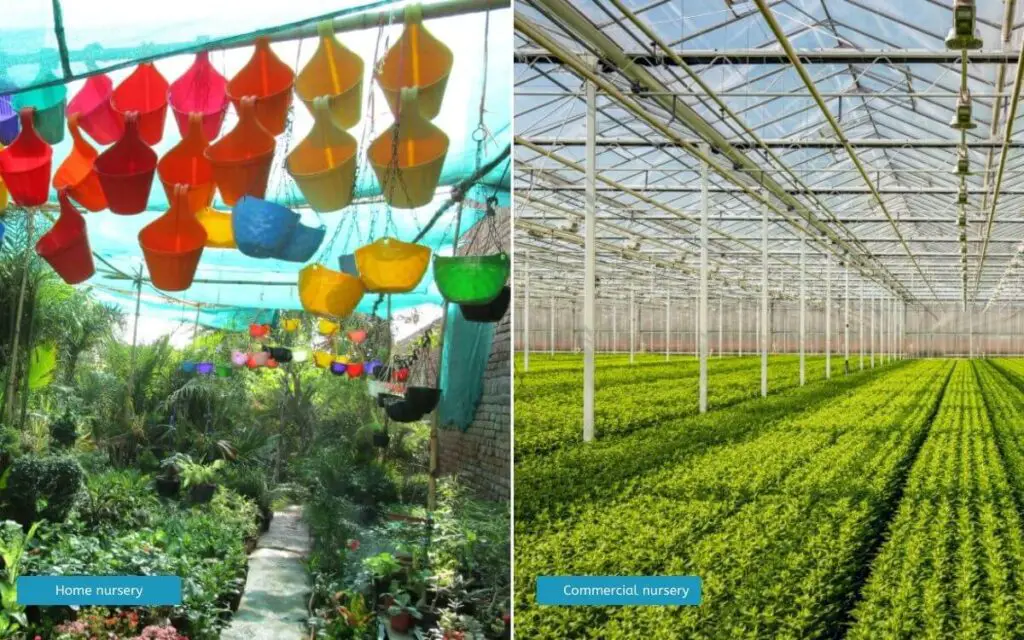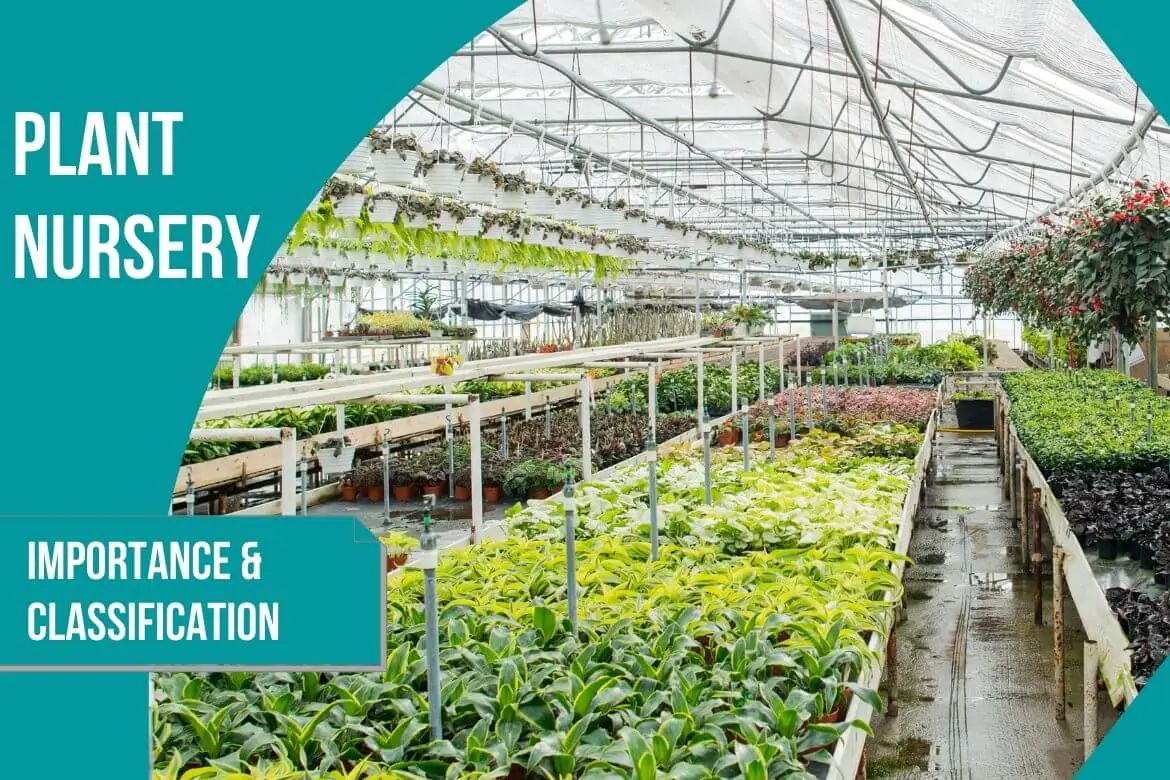Table of Contents
A plant nursery is an establishment that raises, propagates, multiplies, and sells seedlings, saplings, and other planting materials for planting.
Importance of a plant nursery
1 . It is imperative to give the young seedlings special attention in the first few weeks after germination. Young and tender seedlings growing in nursery beds are easier and more economical to care for in a small area than in the mail planting field.
2 . Vegetative propagation is the most common method of propagating fruit crops. Prior to transplanting propagules in the main field, special skill and aftercare are necessary. All of these tasks can be successfully performed by skilled labor in a nursery under controlled conditions.
3 . The best conditions for rooting cuttings and hardening grafts are provided by the mist house chamber in a nursery.
4 . When compared to transplanting of seedlings raised in nurseries, direct sowing is less successful in several crops.
5 . It is necessary to replace plantation casualties either in the year of planting or in the following year. Due to weed suppression, sowing done in the gaps are likely to be unsuccessful. They will not catch up with plant growth from the original sowing. Plants or stumps grown in nurseries are invariably used to replace casualties, so nurseries are indispensable. For causality replacement in orchards, hardened nursery plants are preferred.
6 . Furthermore, it provides more time for pre-planting operations/preparations when seedlings or saplings are raised in nursery.
7 . A nursery is the only place where seedlings can be hardened against natural elements.
8 . There are some plant species that don’t seed every year. It is difficult to raise plants of these species each year. This problem can be solved by collecting all the available seeds from years of good seed production and sowing them in a nursery to raise seedlings that can be transplanted in subsequent years.
9 . The seedlings of some species grow very slowly, and if they are sown directly in main field, they are most likely to become overwhelmed by weeds and die. For this reason, slow-growing species are generally raised in nurseries and planted out only when weeds are unlikely to damage the seedlings.
10 . In order to artificially regenerate barren and poor farming sites, nursery grown plants are the most reliable method.
Types of plant nursery
Broad classification of plant nursery
Plant nurseries can be classified into two categories:

(A) Home nursery
Typically, home nurseries are places where plants are grown and raised exclusively to fulfill the needs of gardeners.
(B) Commercial nursery
Nurseries have a larger collection of plants and are larger in size. These nurseries are primarily concerned with financial returns.
Types of plant nursery based on the time span it is used
(A) Temporary nursery
In a temporary nursery, seeds are planted in a protected area, and after they germinate, the saplings are transferred to the main field. These nurseries can also be called as seed nursery. These nurseries are made very close to the main planting field. After the planting operation is done in the main field, this nursery is disassembled.
Since these nurseries are temporary, they don’t have permanent structures like office area, fixed irrigation systems, fencing etc.
(B) Permanent nursery
These types of nurseries are permanent structures and are made for large scale operations. These nurseries are made to provide saplings and supplied for long term. Hence, these nurseries are equipped with permanent structures such as fixed irrigation systems, fencing, office, packaging area, composting area, pot yard etc.
Types of plant nursery based on irrigation system
(A) Wet nursery
A wet nursery has a permanent arrangement of an irrigation system. These nurseries are not dependent on rainfall. Any type of plant can be grown in these plant nurseries.
(B) Dry nursery
Dry nurseries are primarily used for growing drought resistant plants. These nurseries heavily depend on rainfall as they don’t have a permanent arrangement of irrigation system.
Types of plant nursery based on Plantation layout
(A) Horizontal nursery
The majority of nurseries are horizontal in nature, meaning that they cover the whole land area.
(B) Vertical nursery
Much like vertical farming, vertical nursery has sapling plantation arrangements in multiple levels (not just the ground).
Types of plant nursery based on enclosure
(A) Closed nursery
As suggested by the name, the nursery beds are prepared in a closed enclosure such as greenhouse or a polyhouse or a shade-net structure. These structures have more controlled environments specific to good growth of the seedling.
(B) Open nursery
Open nurseries do not have any kind of roof enclosure. Crop seedlings are grown out in the open with complete exposure to natural elements.
Types of plant nursery based on sales model
(A) Retail Nurseries
Plants are raised in retail nurseries for public sale. Generally these are local nurseries that sell seasonal plants, annuals, ornamental trees, decor, landscaping, and other landscaping supplies to the general public. In addition, these could also be companies that specialize in a particular kind of plant like tropical plants, citrus trees, bulbs or roses.
(B) Wholesale Nurseries
Typically, wholesale plant nurseries grow plants in large volumes so they can sell them to numerous clients. Retailers, such as florists and garden centers, are common clients of wholesale plant nurseries. The plants sold by a wholesale nursery may fall into a particular niche, such as houseplants or vegetables, or they may be part of a larger assortment, such as fruits, vegetables, or landscaping plants.
(C) Private Nurseries
Plants are grown exclusively for one client in a private nursery. This plant nursery can be used by the client on a contractual basis or could also be owned by the client. Institutions, large estates, and corporations are clients of private nurseries.
(D) Mail Order Nurseries
Mail order businesses can be owned by private companies, retail businesses, and wholesale businesses. Dormant ornamental trees and bedding plants can now be shipped by mail as shipping methods are improving.
Establishing a plant nursery: factors that affect it
1 . The location of the site, its topography, climate, and reputation as a financial and transport hub
2 . Soil selection
3 . Access to water
4 . Manures and fertilizers
5 . The availability of labor
Components of a plant nursery
Following are some of the components of a plant nursery
1 . Shed/building structure
It includes the office, the sales counter, the packing shed, the potting shed, the store, the implement shed, and the residential quarters.
2 . Progeny tree block
Choices of type and variety of fruit crops and the collection of true to type mother plants significantly affect the success and goodwill of a plant nursery.
3 . Propagation structures
The propagation of plants is accomplished with structures such as green houses, glass houses, poly houses, hot beds, cold frames, lath houses, shade houses, and mist houses.
4 . Seed bed
Seed beds are smaller areas (when compared to nursery beds) where the germination of seeds is performed. These beds are usually raised and preferably near the office area so that these beds and germination of seeds can be closely monitored.
5 . Nursery bed
Plant nursery bed is the plantation area (sometimes in level with the ground and sometimes raised from the level of the ground) where the small saplings are grown. The small saplings are taken from the seed bed. A typical dimension of a plant nursery bed is 3 meter length x 1 meter width. Furthermore, nursery beds are sectioned where each sections has its own crop variety.
6 . Pot yard
Pot yard is generally used for tender and sensitive plants instead of hardy plants. It is usually made in area where there is ample of shade.
7 . Working yard and packing shed
This place is used by workers for sorting of the saplings and also for packing of sapling before the sale.


1 comment
Good info